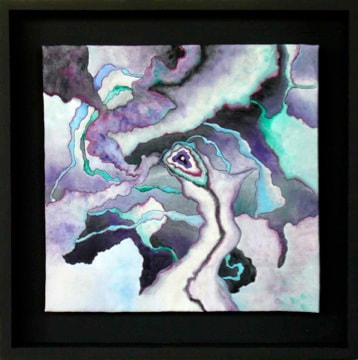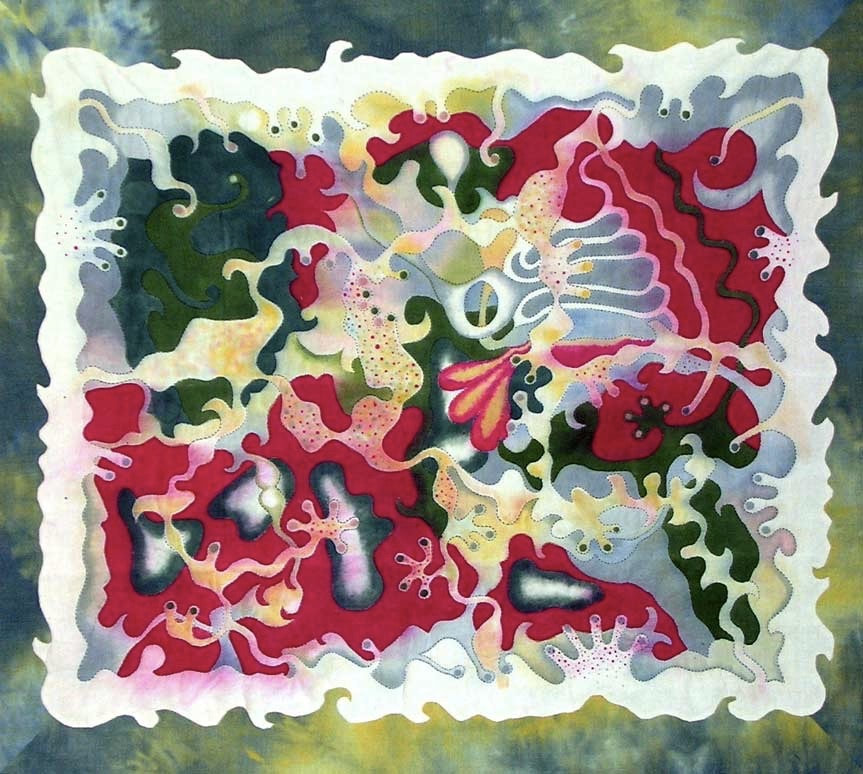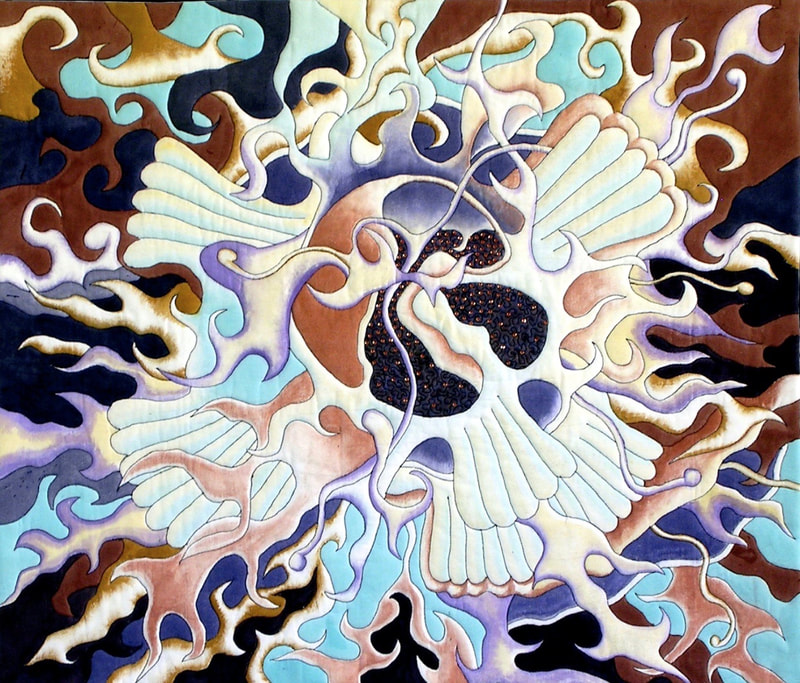Sample Spirit Works
Workshop Details for Spirit Works
From Wikipedia:
|
Surrealism is a cultural movement that developed in Europe in the aftermath of World War I in which artists depicted unnerving, illogical scenes and developed techniques to allow the unconscious mind to express itself.
|
To make a Spirit Works surrealist quilt, stack a white-on-white or white-on-black whole-cloth quilt, and without prior design, free motion machine quilt an image with dark thread. Give the design no prior thought; indeed, give it no thought at all--just do it!
With stitching finished and some design having appeared on the fabric, set up your paints, brushes, palette, and water, and begin to paint. Bind the quilt before or after painting, or stretch and frame the work as you would do a painting on canvas. Add any embellishments like beads, sequins, cords, or other stitchery at any time you deem appropriate.
This workshop is highly experimental. Participants should have some understanding of and practice with meditation. The work requires a deliberate disconnect between cognitive thought about design and permitting oneself to allow creativity to flow subconsciously from the fingers rather than intellectually from the mind.
Each participant creates a one-off work of art, for no one else would ever create the same imagery with this method. Each quilt tells a story that comes from the subconscious. Done properly, each attempt will dredge up memories and thoughts about things that the artists may not be particularly aware of at the time. The images some participants make may prove disturbing. The painting instruction will prove useful for any other painted works the participant wants to make.
Spirit Works is a workshop for those of strong heart, those who are willing to dig deeply into the subconscious mind and confront whatever emerges. Not therapeutical, the experience is more closely akin to remembering . . .
With stitching finished and some design having appeared on the fabric, set up your paints, brushes, palette, and water, and begin to paint. Bind the quilt before or after painting, or stretch and frame the work as you would do a painting on canvas. Add any embellishments like beads, sequins, cords, or other stitchery at any time you deem appropriate.
This workshop is highly experimental. Participants should have some understanding of and practice with meditation. The work requires a deliberate disconnect between cognitive thought about design and permitting oneself to allow creativity to flow subconsciously from the fingers rather than intellectually from the mind.
Each participant creates a one-off work of art, for no one else would ever create the same imagery with this method. Each quilt tells a story that comes from the subconscious. Done properly, each attempt will dredge up memories and thoughts about things that the artists may not be particularly aware of at the time. The images some participants make may prove disturbing. The painting instruction will prove useful for any other painted works the participant wants to make.
Spirit Works is a workshop for those of strong heart, those who are willing to dig deeply into the subconscious mind and confront whatever emerges. Not therapeutical, the experience is more closely akin to remembering . . .
|
|
Supplies for Spirit Works
Materials: Different materials will produce dif- ferent results, so there is plenty of room for ex- perimentation. Synthetic materials will likely prove difficult to handle and results may not be so good.
The absolute essentials include:
- Prepared for dyeing (PFD) or other 100% white cotton fabric, with (optional) compara- ble weave black cotton fabric for backing, washed, dried and ironed before use
- Any other natural fiber fabric you would like to experiment with: silk (stiffen and stabilize with fusible interfacing first), linen, ramie, cotton/linen blends, possibly wool - all washed or drycleaned and ironed or pressed before use
- 1/4” cotton or polyester batting
- Pins to secure the layers while stitching; use
straight, safety or bent safety pins as you pre-
fer - Dark color thread, not necessarily black, for
machine free motion stitching. Dark color resists paint washes, preserves an important outline in the work. - Free motion or darning foot
The absolute essentials include:
- Acrylic fabric or artists’ paints; fabric paints are far less
expensive as they carry less pigment and are intended
for use on fabrics that will be laundered frequently - Acrylic artists’ paintbrushes with synthetic bristles -
rounds, flats, chisels, fans; one or two sable brushes for fine detail work; one or two large fat boar bristle brushes for fast coverage of large areas - A palette knife or spatula; plastic picnic knives and spoons also useful
- A reservoir palette for keeping paints wet over time
- A small bucket or tub for clean water and another one for
dirty water - Small spray bottle filled with clean water for keeping
paint damp - One or more soft cotton rags for wiping brushes, clean-
ing up spills, removing unintentional spots of paint from
the quilt - Vinyl drop cloth to protect table surface
- Optional board on a slant or upright easel
- Electric iron and ironing board for setting the acrylic paint


